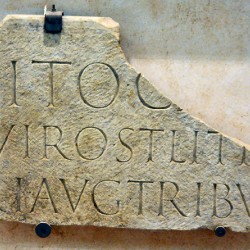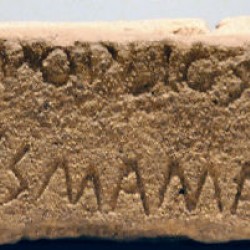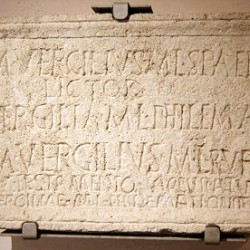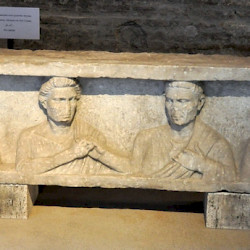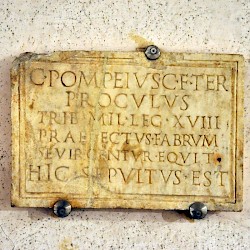Rome, Museo Nazionale Romano - Terme di Diocleziano
Q836108When I visited Rome for the first time, back in ’82, the Museo nazionale romano was closed. I do not recall when I was for the first time able to visit it, although it must have been in the early years of digital photography, because our photos are, as digital files, pretty small. Today, I went back to fill the lacuna.
The rooms in which the inscriptions are exposed, are pretty old. One room, Aula X, is part of the ancient Baths of Diocletian; other rooms belong to a sixteenth-century monastery, which the new Italian state decided to convert into a museum in 1889. Several old private collections, like the objects collected by Athanasius Kircher, became part of the new museum, and the museum expanded when new archaeological finds were added in the twentieth century. It became too large, was closed for a long time, and was finally reopened, with the more artistic part of the collection in the nearby Palazzo Massimo. The rooms in the ancient baths were converted into a museum for Rome’s prehistory and epigraphy.
You will be alone. I noticed two people in the Aula X. There was also a Japanese lady somewhere upstairs. I have not seen any guard.
Of course, epigraphy is not a subject that attracts large crowds. If you go to the epigraphy museum of Athens or Stuttgart’s lapidarium, the guards will be pleasantly surprised that they can welcome visitors. But the unpopularity of epigraphy is undeserved, especially in the Museo nazionale romano. If you see the inscriptions about, for example, freedmen, the signs carefully explain what kind of life they had. You will understand what kind of bureaucracy ran the Empire. Aspects of the cursus honorum are explained: the senatorial careers of the Republic and the Empire, and also the equestrian careers. Other inscriptions tell about the armed forces in the city of Rome. In other words, the museum is essentially about the social history of Rome. As such, it is less beautiful but more interesting than the collection in the Palazzo Massimo.
The most famous inscriptions are in the very first room, where you will see the sixth-century BCE monument that was discovered below the Lapis Niger, and the Lapis Satricanus, an equally ancient inscription that appears to mention Valerius Publicola. Next to it is an old dedication to Castor and Pollux. I was impressed by a small cup that bore the name of Catilina, by the finds from the Tiber related to the cult of Asclepius, by the statues from Ariccia, and by the inscription that was recently discovered near the Meta Sudans. I had never realized that there was an inscription mentioning the historian Tacitus, until I saw it this afternoon.
On the third floor, you will find the inscriptions from ancient Judaism, Mithraism, and Christianity. Some of these texts are from the catacombs, others from a mithraeum found underneath Santo Stefano Rotondo. There’s also the prehistoric collection, which I have not visited this time; I remember it well from an earlier occasion – interesting finds from a/o Gabii – but after three hours of photography, I decided to call it a day.
This museum was visited in a/o 1982, 2009.

